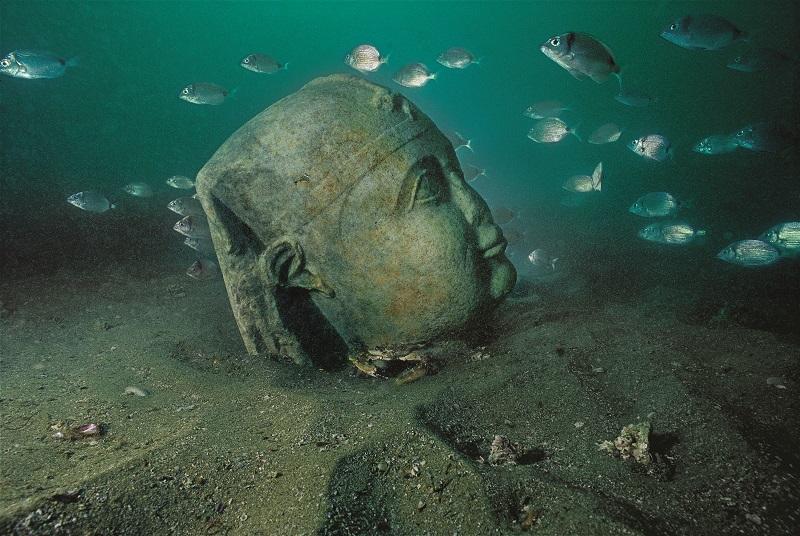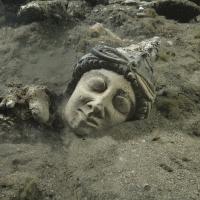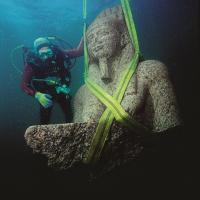Sunken Cities: Egypt's lost worlds rediscovered | reviews, news & interviews
Sunken Cities: Egypt's lost worlds rediscovered
Sunken Cities: Egypt's lost worlds rediscovered
Forgotten for over 1,000 years, eerily evocative treasures take centre stage at the British Museum

In a gallery darkened to evoke the seabed that was its resting place for over a thousand years, the colossal figure of Hapy, the Egyptian god of the Nile flood, greets visitors just as it met sailors entering the busy trading port of Thonis-Heracleion some 2,000 years ago.
They were known about through ancient texts, but it wasn’t until the 1930s that the first remains were discovered, with their exact locations pinpointed at the edge of the Nile delta only 20 years ago. Excavations have been ongoing ever since – an array of objects, beautifully preserved by the sea, offering a vivid picture of two cosmopolitan and culturally diverse cities, their fortunes intimately connected to the power of river and sea.
The fruits of the relationship between Greece and Egypt are seen in the form of sculptures that combine distinct idioms, while devotional objects show the assimilation of Greek and Egyptian gods. After centuries of trade between the two countries, Alexander the Great’s conquest of Egypt in 332 BC saw the beginning of a period of even closer cultural exchange, with Ptolomeic rulers depicting themselves as pharaohs in an attempt to gain acceptance (main picture). An eerily beautiful sculpture of a Ptolomeic queen shows her as the Egyptian god Isis. The walking posture and the use of dark Egyptian stone instead of marble are characteristically Egyptian, as is the treatment of the face. The draperies, and the hair, however, are typically Greek.
Despite the many artefacts that have been recovered, it is thought that only a tiny percentage of the underwater site has been excavated so far. But the picture that emerges is of a complex and nuanced relationship between two great civilisations, in which sculpture played a central role.
- Sunken Cities: Egypt's Lost World's at the British Museum until 27 November
Click on the thumbnails to enlarge
Explore topics
Share this article
The future of Arts Journalism
You can stop theartsdesk.com closing!
We urgently need financing to survive. Our fundraising drive has thus far raised £49,000 but we need to reach £100,000 or we will be forced to close. Please contribute here: https://gofund.me/c3f6033d
And if you can forward this information to anyone who might assist, we’d be grateful.

Subscribe to theartsdesk.com
Thank you for continuing to read our work on theartsdesk.com. For unlimited access to every article in its entirety, including our archive of more than 15,000 pieces, we're asking for £5 per month or £40 per year. We feel it's a very good deal, and hope you do too.
To take a subscription now simply click here.
And if you're looking for that extra gift for a friend or family member, why not treat them to a theartsdesk.com gift subscription?
more Visual arts
 'We are bowled over!' Thank you for your messages of love and support
Much-appreciated words of commendation from readers and the cultural community
'We are bowled over!' Thank you for your messages of love and support
Much-appreciated words of commendation from readers and the cultural community
 Lee Miller, Tate Britain review - an extraordinary career that remains an enigma
Fashion photographer, artist or war reporter; will the real Lee Miller please step forward?
Lee Miller, Tate Britain review - an extraordinary career that remains an enigma
Fashion photographer, artist or war reporter; will the real Lee Miller please step forward?
 Kerry James Marshall: The Histories, Royal Academy review - a triumphant celebration of blackness
Room after room of glorious paintings
Kerry James Marshall: The Histories, Royal Academy review - a triumphant celebration of blackness
Room after room of glorious paintings
 Folkestone Triennial 2025 - landscape, seascape, art lovers' escape
Locally rooted festival brings home many but not all global concerns
Folkestone Triennial 2025 - landscape, seascape, art lovers' escape
Locally rooted festival brings home many but not all global concerns
 Sir Brian Clarke (1953-2025) - a personal tribute
Remembering an artist with a gift for the transcendent
Sir Brian Clarke (1953-2025) - a personal tribute
Remembering an artist with a gift for the transcendent
 Emily Kam Kngwarray, Tate Modern review - glimpses of another world
Pictures that are an affirmation of belonging
Emily Kam Kngwarray, Tate Modern review - glimpses of another world
Pictures that are an affirmation of belonging
 Kiefer / Van Gogh, Royal Academy review - a pairing of opposites
Small scale intensity meets large scale melodrama
Kiefer / Van Gogh, Royal Academy review - a pairing of opposites
Small scale intensity meets large scale melodrama
 Jenny Saville: The Anatomy of Painting, National Portrait Gallery review - a protégé losing her way
A brilliant painter in search of a worthwhile subject
Jenny Saville: The Anatomy of Painting, National Portrait Gallery review - a protégé losing her way
A brilliant painter in search of a worthwhile subject
 Abstract Erotic, Courtauld Gallery review - sculpture that is sensuous, funny and subversive
Testing the boundaries of good taste, and winning
Abstract Erotic, Courtauld Gallery review - sculpture that is sensuous, funny and subversive
Testing the boundaries of good taste, and winning
 Edward Burra, Tate Britain review - watercolour made mainstream
Social satire with a nasty bite
Edward Burra, Tate Britain review - watercolour made mainstream
Social satire with a nasty bite
 Ithell Colquhoun, Tate Britain review - revelations of a weird and wonderful world
Emanations from the unconscious
Ithell Colquhoun, Tate Britain review - revelations of a weird and wonderful world
Emanations from the unconscious
 Rachel Jones: Gated Canyons, Dulwich Picture Gallery review - teeth with a real bite
Mouths have never looked so good
Rachel Jones: Gated Canyons, Dulwich Picture Gallery review - teeth with a real bite
Mouths have never looked so good











Add comment